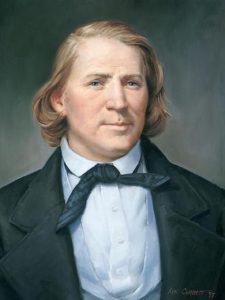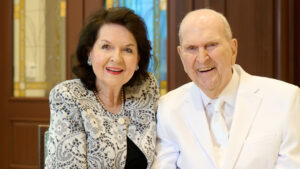
Moving Forward: What You May Have Missed About This Last General Conference
This was certainly a General Conference to remember.
Right before the end of Conference, our beloved apostle Robert D. Hales passed away, concluding an incredible lifelong service that spanned decades of sincere dedication. He was a man of valor in the gospel, and his guidance in these troubling last days will be sorely missed.
This was repeated at the pulpit during the last session. It was tender for me to witness his fellow apostles, notably Elder Anderson in his final talk, pay tribute to this champion of the gospel. It was clear that they grieved his death.
He was grieved, but General Conference did not stop.
The words of the prophets were still spoken. The work still moved forward.
This may seem like an unremarkable occurrence, but it emphasized two important doctrines of the gospel that often go overlooked when important leaders of the Church pass on. These two doctrines are important for us to understand if we are to have the confidence that the Lord’s work will continue to go forward.

1. Revelation Decides Succession
Before he passed, Joseph Smith never got the opportunity to teach his apostles about succession in the Church. As such, there was much confusion about who would take the reigns of leadership.
Sidney Rigdon had some ideas. After being alienated from the Church, he showed up soon after Joseph’s death to testify that he had received a revelation declaring that he should be the new “guardian” of the Church. He campaigned this idea amongst the troubled Saints.
What was interesting about Sidney’s idea is that in the role of guardian, there would be no moving forward as a Church. Instead, he would maintain the same Church that Joseph established until Joseph claimed to reclaim it after his resurrection. Not only did this suggest that there would be no progression, but it also could be taken to mean that Joseph was the head of the Church, not the Savior.
Many Saints were deceived by this teaching. Brigham Young was not one of them. In a special meeting of the Twelve, he declared the following about the keys of the Church:
“I do not care who leads the church … but one thing I must know, and that is what God says about it. I have the keys and the means of obtaining the mind of God on the subject. …
“Joseph conferred upon our heads all the keys and powers belonging to the Apostleship which he himself held before he was taken away, and no man or set of men can get between Joseph and the Twelve in this world or in the world to come.
“How often has Joseph said to the Twelve, ‘I have laid the foundation and you must build thereon, for upon your shoulders the kingdom rests.’”
Most of us know the rest of the story on how Brigham Young then became the next prophet of the Church. In a historic General Conference, Brigham Young and Sidney Rigdon spoke to the Saints about succession. The Saints as a body received a vision from the Lord in which they saw Brigham Young as Joseph Smith, and it was clear that succession belonged in his hands.
There were two principles within this story that are worth noting:
1) Each member of the Twelve is chosen by revelation. The Savior is the Head of the Church, not the presiding prophet. As such, any revelation given to the leaders of the Church is from Him, which removes human error or agenda.
2) We can receive revelation about our leaders. Our Heavenly Father does not expect us to blindly follow the leaders He chooses. When leaders are announced, we are encouraged to kneel in prayer and ask our Heavenly Father if they are truly His servants. When we get our answer, we can have confidence in their decisions and know they are being led by His will.
When a leader passes on, succession is not decided by the other leaders of the Church. Our leaders are chosen by the Savior. This means there is no confusion about who receives the mantle of leadership; there are no political agendas, no campaigning and no dissent amongst the leadership of the Church. The work moves forward.

2. The Savior’s Work Will Progress
Mobbers who killed Joseph Smith assumed that Joseph’s church would die with him.
They couldn’t have been more wrong.
It has now fulfilled prophecy, in that it has “filled the world.” It has gone from a small meeting house with only 6 members to a worldwide church of nearly 16 million members. In the beginning, the work of salvation was performed in only one temple; now, there are 157 temples in operation across the world.
Since Joseph Smith, there have been numerous prophets and apostles who have taken the torch and ran with it. This growth can, in part, be because of the divinity of their ordinations. We are being led by living seers and revelators who are consistently moving forward the Lord’s Kingdom, and nothing, not even death, can stop that work from progressing.
The passing of leaders in the Church is sad, but we don’t need to despair. The stone will roll on under new inspired guidance, and while other churches may rise and fall, The Church of Jesus Christ of Latter-day Saints will continue to fill the world until the Savior comes to reclaim it again.









